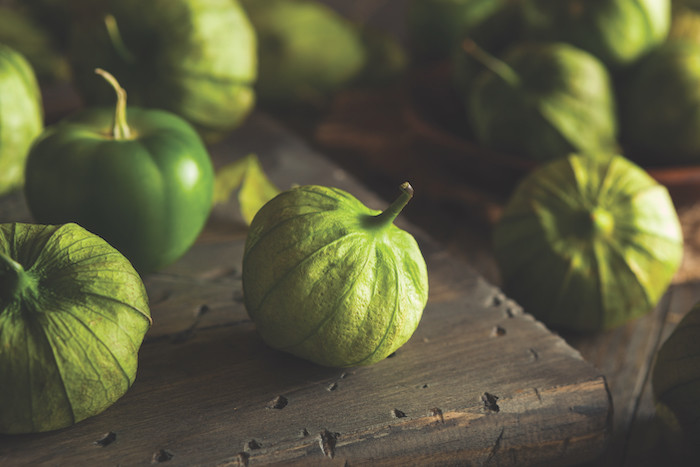
Anistatia Miller and Jared Brown sing the praises of a versatile berry that is easy to grow and can add zing to a Bloody Mary or a Margarita.
OK, tomatoes and tomatillos both originate from Mexico. One looks like a small green version of the other once they pop out of their paper-like casing. But did you know the tomatillo grows surprisingly well in England?
The name tomatillo literally translates to ‘little tomato’. Like the tomato, the tomatillo is technically a berry and a nightshade family member.
However, this doesn’t make it a close cousin to the tomato. Nightshades include potatoes, aubergines, peppers, chillies, goji berries and tobacco. Its closest cousin is the cape gooseberry (physalis). As with other nightshades, tomatillo leaves contain solanine – a toxin – but the berries themselves are safe and delicious.
Even if you were unaware of what they were, if you’ve had salsa verde you have had tomatillos. If you’ve been to Mexico, you’ll find their most common use in bars has historically been in sangrita verdecito (aka: verdita or sangrita verde) – a spicy non-alcoholic chaser that’s served alongside tequila shots. Want to make one? Combine tomatillos, jalapeños, onion, coriander leaves and fresh mint in a blender. Blitz coarsely. Add pineapple juice, lime juice and salt. Blitz again. Strain and refrigerate for a day or two, then serve.
Tomatillos are available fresh in the UK and, far more abundantly, canned – mostly imported from Mexico. Really? Really. Canned tomatillos are of comparable quality to cooked fresh tomatillos. But let’s get back to basics. We said they grow well in the UK.
To grow tomatillos, start seeds indoors in early spring or plant them outdoors after the last frost. They grow similarly to tomato plants, bushing out to as much as a metre across and benefit from being staked up. They do well with standard plant food and even better with Tomorite.
Much to our surprise, they are also self-seeding. We missed clearing a few fallen tomatillos the first year. The next spring, a lovely tomatillo patch emerged on its own. The yellow blossoms and paper lanterns of the fruit make this a very attractive addition to any garden patch. Of course, when harvest time comes, you have as many ways to use these berries as possible. They are prolific.
New classic
Start with a Tomatillo Bloody Mary base. Blitz fresh coriander, tomatillos, green or yellow cherry tomatoes, seedless cucumber, garlic, a seeded Thai chilli and fresh lime juice into a passata-thick mixture. A base of either vodka, London dry gin, or resposado tequila can be topped with a garnish of a spring onion stalk and slices of cucumber.
Next, try a new classic. A Tomatillo Margarita brings everything back home with tequila, triple sec, simple syrup and a juice made with tomatillos, a jalapeño (taste) and lime juice.
Pickled tomatillos are an ingredient favoured by bartenders such as Nik Sparks at Leyenda in New York. Combining distilled white vinegar with tomatillos, garlic, serrano chilli, cumin seeds and black peppercorns, this liquid gets sweetened with white sugar into a syrup as well. These ingredients are combined with manzanilla sherry, dry vermouth, tequila and mezcal to made a Toma-tini.
As we said before, this year’s harvest is rather sizeable. We won’t get through this many tomatillos in a few drinks and a batch or two of salsa verde. Lucky for us, tomatillos can be canned for future use. Put tomatillos in a large saucepan with enough water to cover them and boil them gently until tender—about 5-10 minutes. Drain and loosely pack hot tomatillos into hot, sterile jars, leaving about 2cm of headspace. For every half-litre litre or pint jar, add a tablespoon of fresh lime juice. Fill the jars with boiling water, leaving the same amount of headspace. Remove air bubbles and seal tightly.
During the dark days of winter, the fresh, tangy, citrusy taste of tomatillos will brighten your day. Why not give them a try?


